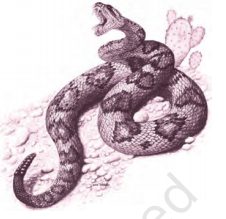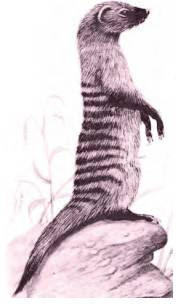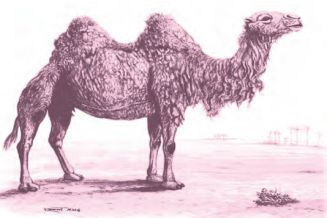By Jyoti Verma
NCERT Solution Class 6 Desert Animals Chapter Explanation, video and Question Answer
Desert Animals Class 6 English Honeysuckle Book Lesson 9– Detailed explanation of the lesson along with the meanings of difficult words.
Also, the explanation is followed by a Summary of the lesson. All the exercises and Question and Answers given at the back of the lesson has been covered.
Class 6 English (Honeysuckle Book) Chapter 9 – Desert Animals
Introduction to Desert Animals
This lesson as the name suggests throws light upon the life of the Desert Animals and their varied unique ways to adapt to the harsh atmosphere.
Summary of Desert Animals Class 6
Desert is a place with no water means the driest place on earth and the lesson ‘Desert Animals’ is all about the animals who live in the desert. It throws light on the ways the animals in the desert adapt themselves to the weather of the desert and the different methods they use to adjust with its harsh life.
Like Gerbils spend the hottest part of the day in their burrows below ground. Darkling beetle drag drops of moisture on their legs , lift them into the air and drop down into their mouth. In the dry, rocky deserts of America lives a snake called ‘Rattlesnake’. It is called rattlesnake because it makes a sound with its tail. Another animal which lives in the desert is a Mongoose. Mongooses love to search for food in groups. They are known for their ability to kill snakes without hurting themselves. The Camel is known for its unique ability to live in the desert. They have long shaggy coats to keep warm in winter which falls away and gets shorter in the summer to keep cool. There are two different kinds of camel in the desert ‘the Dromedary’( It has only single hump) and ‘Bactrian camel’ (It has two humps). People usually think that camel’s hump is a storage container and it stores water in it. But actually, humps are full of fat. This fat feeds the camels when they have nothing to eat. They can use this fat to fill their stomach for days together when there is nothing to eat.
Lesson Explanation
Passage – DESERTS are the driest places on earth and sometimes go for months, or even years, without rain. But even the desert animals cannot survive without water, or for long periods in the scorching sun, so they have had to find different ways of coping with the harsh conditions.
For example, gerbils spend the hottest part of the day in cool underground burrows. And strange insects called darkling beetles are experts at catching drops of moisture on their legs, then lifting them into the air until the drops trickle down into their mouths.
Not all deserts are endless seas of rolling sand dunes. Some are rocky or pebbly and dotted with small bushes while others are sprinkled with colourful flowers during the spring.
Word Meaning
scorching: very hot
gerbils: mouse-like desert rodents with long hind legs
dunes: heaps of sand formed by the wind
pebbly: stony
Explanation of the above Passage – Deserts are the places which have less water and almost no rain for months together and sometimes in a year also. Therefore, they are the driest places on earth. But animals who live here it is difficult for them as well to live without water for a long span of time, especially during hot days of summer. So they find their own alternate ways to beat such difficult conditions of the atmosphere. For example, Gerbils go underground during hot days in their cool burrows. Darkling beetle is an insect which uses a strange way to beat the heat. They drag drops of moisture from their legs lift them in the air and drop them into their mouth. All the deserts are not the same hills of sand. Each has its own characteristics. Some are stony and have a rugged surface with small bushy plants. Few also have colorful flowers during the spring season.

Passage – There are more than 2300 different kinds of snakes around the world, ranging from just fifteen centimetres long to more than eleven metres. Most snakes are quite harmless — but there are a few that are so poisonous they can kill a human being with just one bite. Most snakes lay eggs, but there are many which give birth to their young. In the dry, rocky deserts of America lives a rather evil looking snake with a very bad reputation.
Its frightening rattle can be heard as far as thirty metres away, and it can strike with lightning speed.
Word Meaning
Frightening: scaring
Rattle: sharp knocking sound
Explanation of the above Passage – Snakes are also of many types. There are about 2300 types of snakes. They range from the smallest size that is just 15 centimetres long to more than 11 metres. Most of the snakes are harmless. But few are so poisonous that their one bite is enough to kill anyone. Most of them lay eggs to reproduce but many are there who give birth to their young ones. American deserts are dry and rocky in nature. There lives an evil looking snake with a very bad reputation. One can hear its sharp sound even from a distance of 30 metres. It strikes very fast with lightning speed.
Passage – But the rattlesnake, or ‘rattler’ as it is sometimes called, prefers to avoid people if it possibly can. It holds its tail upright and rattles the end whenever it is disturbed, in the hope that the intruder will go away. However, if its warnings are ignored—and it feels threatened—it will coil ready to bite. But the rattler itself cannot hear the noise its own tail makes. Like most snakes, it ‘hears’ things through vibrations in the ground. If a person walks nearby the snake can feel the movement. But if the same person were to shout, it would not hear a thing. Rattlesnakes are very common and widespread animals, living right across the American continent from Canada to Argentina. They feed on a variety of prey, including mice, voles, rats, chipmunks and many other small animals. Rattlesnakes kill their prey with venom. Like all snakes, they swallow the unfortunate animals whole. Few snakes have to eat more than once a week and some, such as the larger pythons, can survive for a year or more without eating.
Word Meaning
voles: small plant-eating rodents
chipmunks: small ground squirrels having light and dark stripes
Coil: to turn, to make a loop
Vibration: movement
Venom: poisonous toxin
Explanation of the above Passage – There is also the rattler or rattlesnake. Its choice is to avoid people as much as it can. If it feels disturbed, it holds its tail upright and gives a sharp sound to make the intruder move away. But if its warnings are not paid attention and it feels threatened, it will turn around to bite.The strange thing is that it can not hear the sound its tail makes. Like other snakes, it also hears through the waves produced on the ground. Means it can feel the vibration but can not hear the sound. Snake can feel the movement of a walking person but can not hear his voice how loud may he shout. Rattle snakes are commonly found in the American Continent from Canada to Argentina.Their prey choice includes small animals like mice, small plant eating rodents(voles), rats etc. They use poisonous toxin in their body to kill its prey.The way other snakes gulp down or eat animals completely. Their eating habits also vary. Some snakes eat more than once a week and some like large pythons can do without eating for a year or more.

Passage – Mongooses like to hunt together, but they always keep a lookout for dangerous predators nearby. Poking their noses into holes, overturning rocks with their paws and scratching the ground with their sharp claws, banded mongooses are very amusing animals to watch. A common sight in many parts of Africa, they travel in groups of about twenty to forage for beetles, millipedes and other small creatures.
Word Meaning
predator: an animal naturally preying on others.
Amusing: interesting; enjoyable.
forage: search for food
Explanation of the above Passage – Mongooses go hunting in groups. They always keep a place from where they can watch predators near them. It is interesting to watch them banded, poking their nose into holes, overturning rocks with their paws and scratching the ground with their sharp claws. It is very common to view them traveling in groups of about 20. They travel in search of food. Their food is beetles, millipedes and other small creatures.
Passage – They like to hunt together, keeping in touch whenever they go out of sight behind rocks or bushes by twittering and calling. Always on the lookout for danger — hawks, eagles and large snakes — they warn one another with a special alarm call if they spot anything suspicious.
Word Meaning
Twittering: Sparrow’s sound
Suspicious: doubtful
Explanation of the above Passage – They move in groups to search for their food. But if they need to move to places which are not visible like – at the back of bushes or rocks they make sounds like twittering to stay in touch. They take extra care to keep a place from where they can watch the animals who are dangerous for them like hawks, eagles and large snakes. On noticing anything doubtful, they make a special warning call to alert one another.
Passage – Mongooses are famous for being able to kill snakes without getting hurt themselves. Their reactions are so fast that they can dodge each time the snake strikes. They continually make a nuisance of themselves until, after a while, when the snake gets tired, they quickly dive in for the kill.
Word Meaning
dodge: move quickly to avoid its enemy
nuisance: annoyance
Explanation of the above Passage – Mongooses are known for their ability to kill snakes. They don’t even get hurt while doing so. Their reactions are very fast and can move quickly after attacking the snake. They continually keep annoying the snake with their attacks until it gets tired and gets killed.
Passage – All the female mongooses have their kitten at about the same time. They are raised by the whole group in a den made inside an old termite mounds or hollow log. When most of the adults are out looking for food, one or two males stay behind to stand guard until the others return for the night.
Word Meaning
Mound: heap
hollow log: a piece of wood having a hole in it.
Explanation of the above Passage – The peculiar thing in mongooses is that all the females give birth to their babies at the same time. The babies are raised by the whole group. Means looking after the babies is not the responsibility of one rather the whole group. They raise them in a den means the house they have made inside an old termite mound (heap of mud created by termite insect) or in a hollow log. When they go out in search of food two of the male members stay back to look after the babies and wait till the others come back.

Passage – Another animal which lives in the desert is the camel. Camels were first domesticated by people many thousands of years ago. In the wild, camels usually live in small groups of up to thirty animals.
Camels have long, shaggy winter coats to keep warm and shorter, tidier coats in the summer to keep cool. A thirsty camel can drink as much as thirty gallons of water — that’s about five hundred full glasses — in just ten minutes. Normally, however, it gets all the moisture it needs from desert plants and can survive for up to ten months without drinking any water at all.
Word Meaning
Domesticated: to tame to keep at home or any other place
Shaggy: covered with long, untidy hair
Explanation of the above Passage – The Camel is another desert animal. It was first tamed by people, was kept as a domestic animal at homes thousands of years ago. Camels have unique capacities to adjust with their atmosphere like in the forest, they live in small groups of 30 , they have long, untidy hair to use as coat to keep their body warm in winters and this long coat falls away and gets shortened as summer approaches to keep cool. Camels can drink almost 30 gallons, about 500 glasses of water whenever they are thirsty in just 10 minutes. Its body can get moisture from the desert plants and can live without drinking water for up to 10 months.
Passage – There are two different kinds of camels. One, known as the Dromedary, has only a single hump; the other is called a Bactrian and has two humps. The humps help the animal to survive in the desert, by acting as storage containers. But they don’t store water — as many people wrongly believe — they are full of fat. This fat nourishes the camels when food is scarce. If they have nothing to eat for several days, their humps shrink as the fat is used up. There are many other ways in which camels are adapted to desert life. Their mouths are so tough that even the sharp thorn cannot pierce through.
Word Meaning
Scarce: meagre, less in quantity
Pierce : to make hole into
Explanation of the above Passage – Camels are of two kinds- Dromedary which has a single hump and Bactrian which has two humps. The hump is there to help the animal to survive without water in the desert. It acts as a storage container. But it does not store water as people think and believe.These humps are full of fat. This fat feeds the camel when food is less in quantity.When fat is used , the size of the hump becomes smaller as it is used up instead of food. Camels use many other ways as well to live and adjust in the desert. Their mouths are tough and hard. They can even eat thorns and they do not hurt them.
Question and Answers
Talk to your partner and say whether the following statements are true or false.
(i) No animal can survive without water.
(ii) Deserts are endless sand dunes.
(iii) Most snakes are harmless.
(iv) Snakes cannot hear, but they can feel vibrations through the ground.
(v) Camels store water in their humps.
Answers
(i) No animal can survive without water. True
(ii) Deserts are endless sand dunes. True
(iii) Most snakes are harmless. True
(iv) Snakes cannot hear, but they can feel the vibrations through the ground. True
(v) Camels store water in their humps. False
Answer the following questions
(i) How do desert animals survive without water?
A.They adopt varied ways to survive without water like Gerbils move to underground burrows, darkling beetles drag drops of moisture on their legs to their mouths and camels have fat in humps to live without water.
(ii) How do mongooses kill snakes?
A. They kill snakes by annoying them continuously with their attacks and making them
tired with their quick reactions.
(iii) How does the hump of the camels help them to survive when there is no water?
A.Camels eat the fat stored in hump to survive without water.
Read the words/phrases in the box. With your partner find their meaning in the dictionary.
| Harsh conditions harmless survive intruder threatened predators prey continually |
Fill in the blanks in the following passage with the above words/ phrases.
All animals in forests and deserts struggle to —————— in ———————— .
Though most of the animals are ——————, some are dangerous when ——————.
If an ———————— is noticed, they attack or bite to save themselves.
They struggle ——————— for food and water.
Some animals are called ———————— because they —————— on other animals.
Answers
All animals in forests and deserts struggle to survive in harsh conditions .
Though most of the animals are harmless, some are dangerous when threatened.
If an intruder is noticed, they attack or bite to save themselves.
They struggle continually for food and water.
Some animals are called predators because they prey on other animals.
Look at these sentences.
Animals cannot survive for long without water.
So desert animals have to find different ways of coping.
The first sentence says what cannot happen or be done; the second tells us what must, therefore, be done, what it is necessary to do.
Complete these sentences using cannot and have to/has to.
1. You —————————— reach the island by land or air; you —————————— go by boat.
2. We —————————— see bacteria with our eyes; we —————————— look at them through a microscope.
3. He—————————— have a new bicycle now; he ——————— wait till next year
4. Old people often —————————— hear very well; they —————————— use a hearing aid.
5. Road users —————————— do what they wish; they ————— follow the traffic rules.
6. She —————————— accept this decision; she ——————— question it
7. You —————————— believe everything you hear; you —————————— use your own judgement.
Answer:
1. You have to reach the island by land or air; you cannot go by boat.
2. We cannot see bacteria with our eyes; we have to look at them through a microscope.
3. He cannot have a new bicycle now; he has to wait till next year
4. Old people often cannot hear very well; they have to use a hearing aid.
5. Road users cannot do what they wish; they have to follow the traffic rules.
6. She cannot accept this decision; she has to question it
7. You cannot believe everything you hear; you have to use your own judgement.